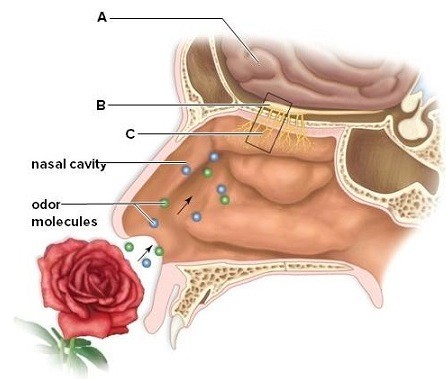Identify the labeled structures that are involved in olfaction. Briefly describe the function of each structure.  A: ________B: ________C: ________
A: ________B: ________C: ________
What will be an ideal response?
A: frontal lobe of cerebral hemisphere: The frontal lobe of cerebral hemisphere is the part of the brain that receives and interprets sensory information from the olfactory tract to identify an odor.
B: olfactory bulb: The olfactory bulb is an extension of the brain. The neurons in the olfactory bulb transmit "smell information" from the olfactory cells in the nasal cavity through the olfactory tract to the olfactory areas of the cerebral cortex.
C: olfactory epithelium: Olfactory epithelium, located high in the roof of the nasal cavity, is the location of between 10-20 million olfactory cells.
You might also like to view...
A researcher is looking at different petri dishes containing the yeast C. albicans. In the first dish she evaluates, she notices that the yeast does not form hyphae. Is this a mutant strain of yeast?
A. Yes, as the lack of hyphae denotes pathogenic yeast. B. Yes, as yeast typically forms hyphae. C. No, as yeast does not normally form hyphae. D. No, as yeast always forms rhizoids and not hyphae.
With more than ____ species, flowering plants dominate the plant kingdom
a. 100,000 b. 175,000 c. 260,000 d. 375,000 e. 480,000
The cluster of capillaries in a Bowman’s capsule is called the ____
a. loop of Henle b. glomerulus c. distal tubule d. proximal tubule e. afferent vessel
In the eighteenth and nineteenth centuries, people increased Earth's capacity to support more humans through ________ advances
A) demographic B) social-medical C) industrial-agricultural D) psychological E) cultural